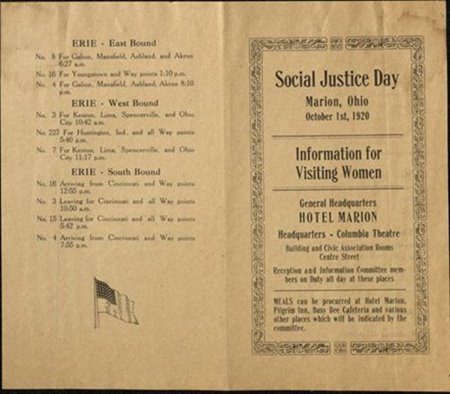One of the specific type of collections that I get to work with here at the Ohio History Connection is our vertical file manuscripts (VFM). These are very small collections, holding things like a single news article, brochure, advertisement, or even a handwritten letter.
So why such small collections? Libraries adopted vertical files long ago as a way to provide quick references for common questions. Think of it a little like a paper version of Google. Because much of the archival material in our VFMs is rare enough to elude a common Google search, these vertical files remain very useful, especially early in a researcher’s quest for information.
I catalog these VFMs, which means I create records for each one on our online catalog, so that they can be found by researchers. In this process, I get to read about so many topics. Sometimes I find VFMs that interest me to the point that I need to know more. This happened again a few days ago.
The VFM that I was cataloging is titled “VFM 3640 Social Justice Day, 1920.”

Inside the folder was a small pamphlet detailing “Information for Visiting Women” attending Social Justice Day in Marion, Ohio, on October 1st, 1920. The pamphlet lists trains that left from Marion that day destined for many locations across the state. Whatever Social Justice Day was, it sounded important. But I was also interested in this travel information. As a group that probably did not travel alone very often, this could have been the key to women being able to confidently attend Social Justice Day.
So what was Social Justice Day? After a little more research using our collections, I discovered that on this day many women from across Ohio and neighboring states, including many nationally known suffragettes, marched through Marion to hear Senator Warren G. Harding give a campaign speech from his front porch.
Women carried signs saying things such as “We Worked, We Waited, We Won” or “We are 2,000 Strong for Senator and Mrs. Harding.[1]”
Among the attendees to Social Justice Day was Mrs. Maud Wood Park, the National Chairman of the League for Woman Voters. She and her delegation delivered their political platforms to both Harding and his opponent, Governor Cox. They then conducted interviews with each candidate, so as to report back to the women voters across the United States about these candidates’ stances on issues that affected women the most (a report was made in the Women’s Suffrage Headquarters New Bulletin, published in Ohio)[2]. During his speech on Social Justice Day, Harding supported many of the items on the women’s platform when he proposed the “establishment of a ‘department of public welfare.3]’”
As I was reading through microfilmed newspapers to figure out what exactly Social Justice Day was, one description that particularly struck me came from the Marion Tribune: “It was the largest demonstration since notification day and indicates that women are interested in their new franchise privileges.[4]
Only two months earlier, in August 1920, the 19th Amendment had passed giving women the right to vote. Within these two months the existing infrastructure of suffrage leagues quickly transitioned to active voter’s organizations as women across the country eagerly educated themselves about the issues on which they would vote. Women attending Social Justice Day were experiencing a first for women in their nation, and undoubtedly filled with excitement to get to the ballot box.
The Woman Citizen, a nationally recognized women’s suffrage publication, summed it up best when they wrote:
“One thing was settled by Mr. Harding’s speech to the women on Social Justice Day,
and that is that the advent of women in politics has already borne fruit and that the things in which they are
most deeply interested will have a new place in the world now that they have votes.[5]”

Florence Harding becomes the first First Lady to vote.
It’s amazing how much information one can learn from interest in a single VFM! Even if you aren’t an academic researcher, our collection offers so many amazing stories of the past. If you’re interested in learning more about Social Justice Day, below are the sources within our collection that I consulted (all of these can be searched in our online catalog). With a visit to the Archives Library, you may find even more!
VFM 3640 Social Justice Day
PA Box 183 59 [PA stands for pamphlet]
FLM 369 Vol. 1-5 Women’s Suffrage Headquarters Bulletin [Microfilm]
Microfilm Roll 22277 Marion Ohio Tribune 1920/08/02 – 1920/10/10
Microfilm Roll 9153 Marion Star 1920/09/01 – 1920/11/22
[1] Marion Star, October 1, 1920.
[2] “Summary of Interviews with Presidential Candidates.” Women’s Suffrage Headquaters News Bulletin [Ohio] 1 Nov. 1920.
[3] “Favors a New Department.” Marion Tribune 1 Oct. 1920.
[4] “Favors a New Department.” Marion Tribune 1 Oct. 1920.
[5] Qtd in. Women’s Suffrage Headquarters News Bulletin [Ohio] 15 Oct. 1920.